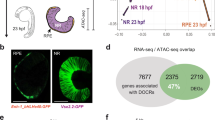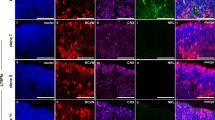Abstract
Understanding the molecular mechanisms by which distinct cell fate is determined during organogenesis is a central issue in development and disease. Here, using conditional gene ablation in mice, we show that the transcription factor Otx2 is essential for retinal photoreceptor cell fate determination and development of the pineal gland. Otx2-deficiency converted differentiating photoreceptor cells to amacrine-like neurons and led to a total lack of pinealocytes in the pineal gland. We also found that Otx2 transactivates the cone-rod homeobox gene Crx, which is required for terminal differentiation and maintenance of photoreceptor cells. Furthermore, retroviral gene transfer of Otx2 steers retinal progenitor cells toward becoming photoreceptors. Thus, Otx2 is a key regulatory gene for the cell fate determination of retinal photoreceptor cells. Our results reveal the key molecular steps required for photoreceptor cell-fate determination and pinealocyte development.
This is a preview of subscription content, access via your institution
Access options
Subscribe to this journal
Receive 12 print issues and online access
$209.00 per year
only $17.42 per issue
Buy this article
- Purchase on Springer Link
- Instant access to full article PDF
Prices may be subject to local taxes which are calculated during checkout







Similar content being viewed by others
References
Furukawa, T., Morrow, E.M. & Cepko, C.L. Crx, a novel otx-like homeobox gene, shows photoreceptor-specific expression and regulates photoreceptor differentiation. Cell 91, 531–541 (1997).
Chen, S. et al. Crx, a novel Otx-like paired-homeodomain protein, binds to and transactivates photoreceptor cell-specific genes. Neuron 19, 1017–1030 (1997).
Furukawa, T., Morrow, E.M., Li, T., Davis, F.C. & Cepko, C.L. Retinopathy and attenuated circadian entrainment in Crx-deficient mice. Nat. Genet. 23, 466–470 (1999).
Freund, C.L. et al. Cone-rod dystrophy due to mutations in a novel photoreceptor-specific homeobox gene (CRX) essential for maintenance of the photoreceptor. Cell 91, 543–553 (1997).
Swain, P.K. et al. Mutations in the cone-rod homeobox gene are associated with the cone-rod dystrophy photoreceptor degeneration. Neuron 19, 1329–1336 (1997).
Sohocki, M.M. et al. A range of clinical phenotypes associated with mutations in CRX, a photoreceptor transcription-factor gene. Am. J. Hum. Genet. 63, 1307–1315 (1998).
Freund, C.L. et al. De novo mutations in the CRX homeobox gene associated with Leber congenital amaurosis. Nat. Genet. 18, 311–312 (1998).
Simeone, A., Acampora, D., Gulisano, M., Stornaiuolo, A. & Boncinelli, E. Nested expression domains of four homeobox genes in developing rostral brain. Nature 358, 687–690 (1992).
Simeone, A. et al. A vertebrate gene related to orthodenticle contains a homeodomain of the bicoid class and demarcates anterior neuroectoderm in the gastrulating mouse embryo. EMBO J. 12, 2735–2747 (1993).
Vandendries, E.R., Johnson, D. & Reinke, R. orthodenticle is required for photoreceptor cell development in the Drosophila eye. Dev. Biol. 173, 243–255 (1996).
Ang, S.L. et al. A targeted mouse Otx2 mutation leads to severe defects in gastrulation and formation of axial mesoderm and to deletion of rostral brain. Development 122, 243–252 (1996).
Acampora, D. et al. Forebrain and midbrain regions are deleted in Otx2−/− mutants due to a defective anterior neuroectoderm specification during gastrulation. Development 121, 3279–3290 (1995).
Matsuo, I., Kuratani, S., Kimura, C., Takeda, N. & Aizawa, S. Mouse Otx2 functions in the formation and patterning of rostral head. Genes Dev. 9, 2646–2658 (1995).
Bovolenta, P., Mallamaci, A., Briata, P., Corte, G. & Boncinelli, E. Implication of OTX2 in pigment epithelium determination and neural retina differentiation. J. Neurosci. 17, 4243–4252 (1997).
Nothias, F., Fishell, G. & Ruiz i Altaba, A. Cooperation of intrinsic and extrinsic signals in the elaboration of regional identity in the posterior cerebral cortex. Curr. Biol. 8, 459–462 (1998).
Baas, D. et al. The subcellular localization of Otx2 is cell-type specific and developmentally regulated in the mouse retina. Brain Res. Mol. Brain Res. 78, 26–37 (2000).
Martinez-Morales, J.R., Signore, M., Acampora, D., Simeone, A. & Bovolenta, P. Otx genes are required for tissue specification in the developing eye. Development 128, 2019–2030 (2001).
Viczian, A.S., Vignali, R., Zuber, M.E., Barsacchi, G. & Harris, W.A. XOtx5b and XOtx2 regulate photoreceptor and bipolar fates in the Xenopus retina. Development 130, 1281–1294 (2003).
Furukawa, A., Koike, C., Lippincott, P., Cepko, C.L. & Furukawa, T. The mouse Crx 5′-upstream transgene sequence directs cell-specific and developmentally regulated expression in retinal photoreceptor cells. J. Neurosci. 22, 1640–1647 (2002).
Sakai, K. & Miyazaki, J. A transgenic mouse line that retains Cre recombinase activity in mature oocytes irrespective of the cre transgene transmission. Biochem. Biophys. Res. Commun. 237, 318–324 (1997).
Tian, E., Kimura, C., Takeda, N., Aizawa, S. & Matsuo, I. Otx2 is required to respond to signals from anterior neural ridge for forebrain specification. Dev Biol 242, 204–223 (2002).
Courtois, V. et al. New Otx2 mRNA isoforms expressed in the mouse brain. J. Neurochem. 84, 840–853 (2003).
Haverkamp, S. & Wassle, H. Immunocytochemical analysis of the mouse retina. J. Comp. Neurol. 424, 1–23 (2000).
Dyer, M.A. & Cepko, C.L. The p57Kip2 cyclin kinase inhibitor is expressed by a restricted set of amacrine cells in the rodent retina. J. Comp. Neurol. 429, 601–614 (2001).
Turner, D.L. & Cepko, C.L. A common progenitor for neurons and glia persists in rat retina late in development. Nature 328, 131–136 (1987).
Marquardt, T. et al. Pax6 is required for the multipotent state of retinal progenitor cells. Cell 105, 43–55 (2001).
Wang, S.W. et al. Requirement for math5 in the development of retinal ganglion cells. Genes Dev. 15, 24–29 (2000).
Brown, N.L., Patel, S., Brzezinski, J. & Glaser, T. Math5 is required for retinal ganglion cell and optic nerve formation. Development 128, 2497–2508 (2001).
Kanekar, S. et al. Xath5 participates in a network of bHLH genes in the developing Xenopus retina. Neuron 19, 981–994 (1997).
Liu, W., Mo, Z. & Xiang, M. The Ath5 proneural genes function upstream of Brn3 POU domain transcription factor genes to promote retinal ganglion cell development. Proc. Natl. Acad. Sci. USA 98, 1649–1654 (2001).
Dyer, M.A., Livesey, F.J., Cepko, C.L. & Oliver, G. Prox1 function controls progenitor cell proliferation and horizontal cell genesis in the mammalian retina. Nat. Genet. 34, 53–58 (2003).
Mears, A.J. et al. Nrl is required for rod photoreceptor development. Nat. Genet. 29, 447–452 (2001).
Yan, R.T. & Wang, S.Z. neuroD induces photoreceptor cell overproduction in vivo and de novo generation in vitro. J. Neurobiol. 36, 485–496 (1998).
Morrow, E.M., Furukawa, T., Lee, J.E. & Cepko, C.L. NeuroD regulates multiple functions in the developing neural retina in rodent. Development 126, 23–36 (1999).
Hatakeyama, J., Tomita, K., Inoue, T. & Kageyama, R. Roles of homeobox and bHLH genes in specification of a retinal cell type. Development 128, 1313–1322 (2001).
Inoue, T. et al. Math3 and NeuroD regulate amacrine cell fate specification in the retina. Development 129, 831–842 (2002).
Tomita, K., Moriyoshi, K., Nakanishi, S., Guillemot, F. & Kageyama, R. Mammalian achaete-scute and atonal homologs regulate neuronal versus glial fate determination in the central nervous system. EMBO J. 19, 5460–5472 (2000).
Ezzeddine, Z.D., Yang, X., DeChiara, T., Yancopoulos, G. & Cepko, C.L. Postmitotic cells fated to become rod photoreceptors can be respecified by CNTF treatment of the retina. Development 124, 1055–1067 (1997).
Blackshaw, S. & Snyder, S.H. Developmental expression pattern of phototransduction components in mammalian pineal implies a light-sensing function. J. Neurosci. 17, 8074–8082 (1997).
Bobola, N. et al. OTX2 homeodomain protein binds a DNA element necessary for interphotoreceptor retinoid binding protein gene expression. Mech. Dev. 82, 165–169 (1999).
Gamse, J.T. et al. Otx5 regulates genes that show circadian expression in the zebrafish pineal complex. Nat. Genet. 30, 117–121 (2002).
Plouhinec, J.L. et al. The Mammalian crx genes are highly divergent representatives of the otx5 gene family, a gnathostome orthology class of orthodenticle-related homeogenes involved in the differentiation of retinal photoreceptors and circadian entrainment. Mol. Biol. Evol. 20, 513–521 (2003).
Gu, H., Zou, Y.R. & Rajewsky, K. Independent control of immunoglobulin switch recombination at individual switch regions evidenced through Cre-loxP-mediated gene targeting. Cell 73, 1155–1164 (1993).
Laird, D.W. & Molday, R.S. Evidence against the role of rhodopsin in rod outer segment binding to RPE cells. Invest. Ophthalmol. Vis. Sci. 29, 419–428 (1988).
Furukawa, T., Kozak, C.A. & Cepko, C.L. rax, a novel paired-type homeobox gene, shows expression in the anterior neural fold and developing retina. Proc. Natl. Acad. Sci. USA 94, 3088–3093 (1997).
Walther, C. & Gruss, P. Pax-6, a murine paired box gene, is expressed in the developing CNS. Development 113, 1435–1449 (1991).
Acknowledgements
We thank J. Miyazaki for the CAG-CAT-Z mice; R.S. Molday for the anti-rhodopsin antibody; K.Rajewsky for the Cre plasmid; P.V. Lippincott, A. Tani, T. Nakane, M. Murai and H. Yoshii for technical assistance; L.F. Parada, J.M. Graff, M. Henkemeyer and J. Jiang for their encouragement. This work was supported by Precursory Research for Embryonic Science and Technology (PRESTO), Dynamics of Development systems and Advanced Brain Science, Grant-in-Aid for Scientific Research on Priority Areas and Grant-in-Aid for Young Scientists (B).
Author information
Authors and Affiliations
Corresponding author
Ethics declarations
Competing interests
The authors declare no competing financial interests.
Supplementary information
Supplementary Fig. 1.
A model for photoreceptor development and gene regulation. (a) Otx2 expression begins at a stage of priming of the photoreceptor cell fate. At a stage of fixation, Otx2 upregulates Crx, and once Crx is induced, it upregulates itself by autoregulation. Terminal differentiation occurs through upregulation of various photoreceptor-specific genes by Crx and possibly Otx2. (b) A part of common progenitor cells exits the cell cycle and chooses the photoreceptor lineage. Otx2 fixes the pre-committed precursors to the committed photoreceptor precursor status. If Otx2 is ablated before fixing to the committed status, the pre-committed precursors are induced to die or affected to change their cell fate into amacrine neurons. Crx induces terminal differentiation of the committed photoreceptor precursors into mature rods and cones. (PDF 255 kb)
Rights and permissions
About this article
Cite this article
Nishida, A., Furukawa, A., Koike, C. et al. Otx2 homeobox gene controls retinal photoreceptor cell fate and pineal gland development. Nat Neurosci 6, 1255–1263 (2003). https://doi.org/10.1038/nn1155
Received:
Accepted:
Published:
Issue Date:
DOI: https://doi.org/10.1038/nn1155
This article is cited by
-
Neuronal migration prevents spatial competition in retinal morphogenesis
Nature (2023)
-
Single cell transcriptomics reveals lineage trajectory of retinal ganglion cells in wild-type and Atoh7-null retinas
Nature Communications (2021)
-
Direct Reprogramming of Somatic Cells to Neurons: Pros and Cons of Chemical Approach
Neurochemical Research (2021)
-
Cis-regulatory analysis of Onecut1 expression in fate-restricted retinal progenitor cells
Neural Development (2020)
-
Brain-specific homeobox Bsx specifies identity of pineal gland between serially homologous photoreceptive organs in zebrafish
Communications Biology (2019)



